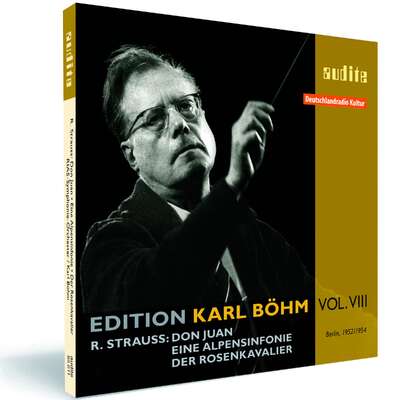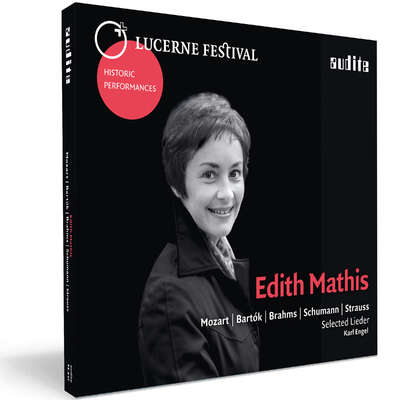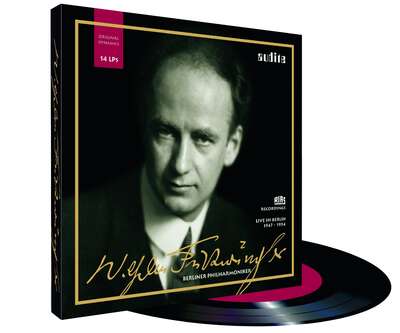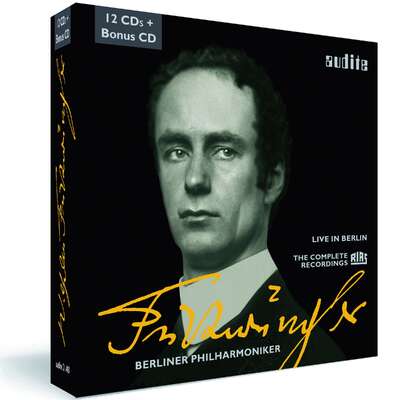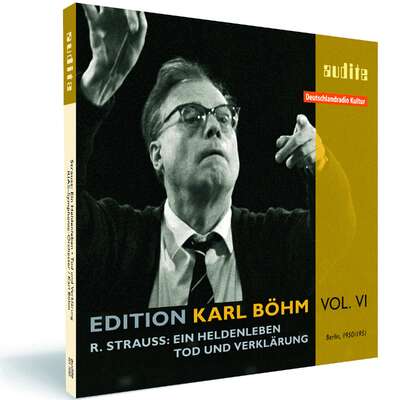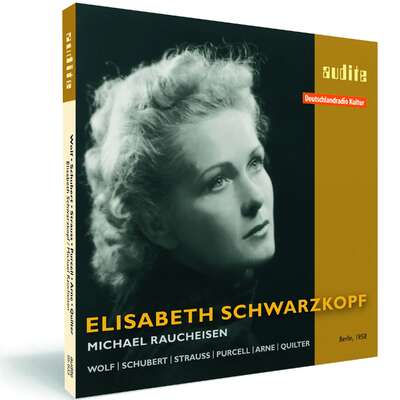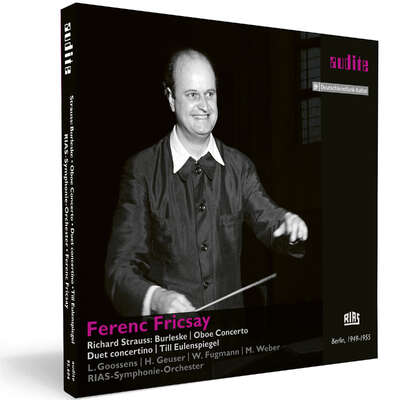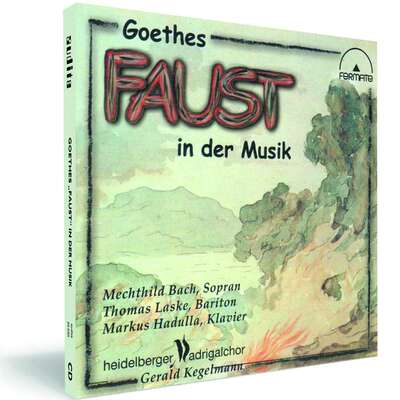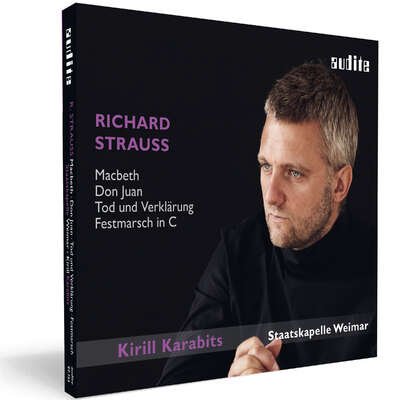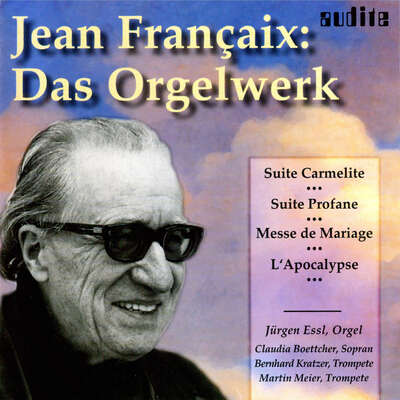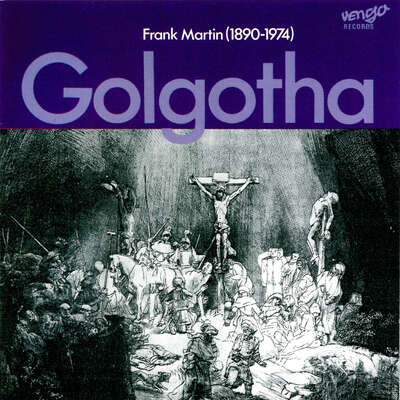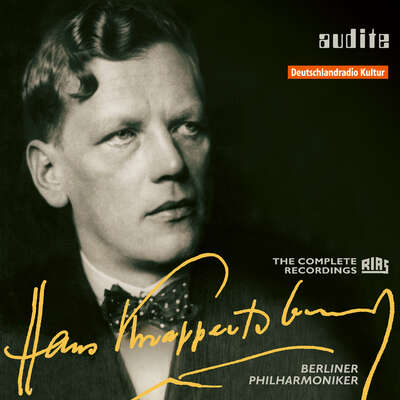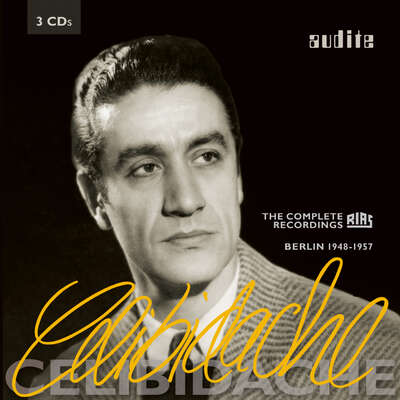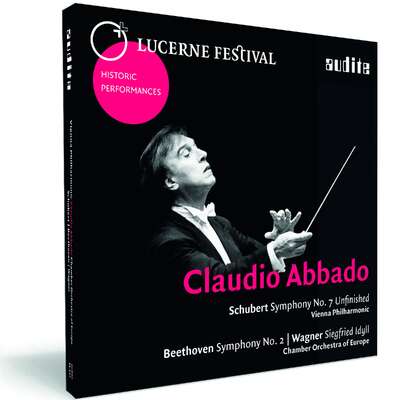
Even in the twilight of her illustrious career, which lasted over three decades, Kirsten Flagstad was still in command of her incomparably rich voice.more
Even in the twilight of her illustrious career, which lasted over three decades, Kirsten Flagstad was still in command of her incomparably rich voice.
Track List
Details
| Kirsten Flagstad sings Wagner & Strauss | |
| article number: | 23.416 |
|---|---|
| EAN barcode: | 4022143234162 |
| price group: | BCA |
| release date: | 6. August 2010 |
| total time: | 96 min. |
Bonus Material
Informationen
These recordings were made on 9 and 11 May 1952 and document the latter part of Kirsten Flagstad’s career. They were made a few weeks before her 57th birthday, thus at a time when most sopranos will have been forced to change over to the so-called character fach. The Norwegian soprano however, even at this late stage, was still in almost full command of her incomparably rich voice, even after a demanding career spanning over three decades.
The present recordings of two concerts given at the Berlin Titania-Palast with the Orchestra of the Municipal Opera are particularly noteworthy: on the one hand, the Wagner songs sound fresher and more present than in the recording made four years later under Hans Knappertsbusch; on the other, the Berlin live-recording of the Strauss songs is technically far superior to the recording made in London. By the way, in May 1950 Kirsten Flagstad had given the first performance of the “Four Last Songs” by Richard Strauss – at the request of the composer.
A tribute to her unique status was also the multitude of her concert engagements: During the course of her career, she sang more than eighty parts in around 2100 performances and also gave approximately 250 concerts with orchestra and 600 recitals.
For this production there are two “Producer’s Comments”:
- Producer's Comment by producer Ludger Böckenhoff/audite
- Producer's Comment by Rüdiger Albrecht/audio archives Deutschlandradio Kultur
The production is part of our series “Legendary Recordings” and bears the quality feature “1st Master Release”. This term stands for the excellent quality of archival productions at audite. For all historical publications at audite are based, without exception, on the original tapes from broadcasting archives. In general these are the original analogue tapes, which attain an astonishingly high quality, even measured by today‘s standards, with their tape speed of up to 76 cm/sec. The remastering – professionally competent and sensitively applied – also uncovers previously hidden details of the interpretations. Thus, a sound of superior quality results. CD publications based on private recordings from broadcasts or old shellac records cannot be compared with these.
Reviews
Fono Forum | Dezember 2011 | Andreas Kunz | December 1, 2011 Empfehlungen unserer Mitarbeiter 2011
Historische Aufnahme des Jahres:<br /> <br /> "Kirsten Flagstad singt Lieder von Wagner und Strauss" (Audite): In puncto Klangvolumen bleibt ihre Stimme wohlMehr lesen
"Kirsten Flagstad singt Lieder von Wagner und Strauss" (Audite): In puncto Klangvolumen bleibt ihre Stimme wohl unübertroffen.
"Kirsten Flagstad singt Lieder von Wagner und Strauss" (Audite): In puncto Klangvolumen bleibt ihre Stimme wohl
The Epoch Times | Apr 26, 2011 | Michael Sherwin | April 26, 2011 Kirsten Flagstad: Live in Havana and Berlin
Two recently issued and historically significant CDs allow us to hear theMehr lesen
klassik.com
| 23.04.2011 | Dr. Claudia Maria Korsmeier | April 23, 2011 | source: http://magazin.k...
Kritik zu Audite: Kirsten Flagstad singt: Lieder von Wagner und Strauss
Altersgrenzen?
Nicht nur in der sogenannten U-Musik ist eines der großen, nahezuMehr lesen
ARCS Journal | March 30, 2011
Audite has also issued Kirsten Flagstad: Richard Wagner and RichardMehr lesen
Fono Forum | März 2011 | Bjorn Woll | March 1, 2011 Starke Stimmen für starke Scheite
Drei hochdramatische Soprane erinnern auf Platte an ein goldenes Zeitalter des Gesangs. Im Zentrum steht dabei vor allem ein Komponist: RichardMehr lesen
Der Fall Eileen Farrell gehört zu den Absonderlichkeiten des Klassikbetriebes. Erst im Alter von 40 Jahren debütierte die Sängerin an der Met, stand dort in sechs verschiedenen Rollen gerade einmal 47-mal auf der Bühne – und verließ das Haus nach nur sechs Jahren. Ihre Stimme jedoch gehört zweifelsohne zu den außergewöhnlichsten dramatischen Sopranen des letzten Jahrhunderts. Das erste Mal begegnete ich der Stimme Farrells auf einer DVD (VAI/Codæx) mit Alcestes Arie "Divinités du Styx" – ein luxurierender Sopran mit einem beeindruckenden Klangstrom –, und die bei Testament erschienene Aufnahme bestätigt das akustische Gedächtnis: Die Stimme verfügt über eine grandiose Fülle und einen üppig-reichen Klang. Ein Kritiker brachte es einmal auf den Punkt: "Sie ist unter den Sängern das, was Niagara unter den Wasserfällen ist." Zu Recht gerühmt wird ihre Aufnahme der "Wesendonck-Lieder" unter Bernstein; die nun vorliegende frühere Aufnahme unter Leopold Stokowski steht dieser in nichts nach, die Stimme wirkt sogar noch etwas frischer. Ihre Interpretation öffnet ozeanische Klangräume ("Träume") von schier endloser Fläche, was ihr mehr liegt als die exaltierte Emphase. Das ist auch das Einzige, was ihr "Heil dir, Sonne" aus "Siegfried" trübt: Immer hat ihr Gesang etwas Distanziert-Majestätisches, der große Ausbruch lag ihr nicht. Doch Autorität und Grandeur ("Ewig war ich, ewig bin ich") ihres Singens sind dafür Entschädigung genug. Sehr gut restaurierter Mono-Klang!
Ein ähnliches Schicksal wie Eileen Farrell ereilte Ingrid Bjoner, denn auch die norwegische Sopranistin ist (fast) der Vergessenheit anheimgefallen, weder Jürgen Kesting noch Jens Malte Fischer erwähnen sie in ihren Gesangslexika. Die norwegische Sängerin gehörte fast 30 Jahre dem Ensemble der Bayerischen Staatsoper an, auf deren Veröffentlichungen beim Label Orfeo sie post mortem zu späten Plattenehren kommt. Sie verfügte zwar nicht über die Klangfülle Farrells, doch ihre in allen Lagen ausgeglichene Stimme konnte in der Höhe wahre Leuchtfeuer entzünden. Die Killerpartie der Turandot bewältigt sie mit imperialer Autorität, dazu mit brennender Intensität, Beethovens "Leonoren"-Arie zudem mit dynamischer Flexibilität und erstaunlicher Virtuosität – und wiederum einigen gleißenden Noten. Im Gegensatz zu vielen Hochdramatischen klingt sie nie matronenhaft, und auch das oft charakteristische Vibrato-Wackeln ist nicht zu hören. Den "Sturz" in der gefürchteten Passage bis zum hohen B verzeiht man ihr. Als Brünnhilde versengt sie den Siegfried von Jean Cox und beeindruckt im Schlussgesang. Die Stimme ist hier, 1976, deutlich gereift, souverän geführt und stets textverständlich. Immer wieder durchleuchtet sie den Text und findet den richtigen Ausdruck im Klang ("Wisst Ihr wie das ward?"). Leicht durchwachsener Live-Sound.
Brünnhildes Schlussgesang findet sich auch auf einer CD mit Orchesterauszügen aus Wagner-Opern mit Wilhelm Furtwängler – gesungen von der großen Kirsten Flagstad. Selbst Farrell verfügte nicht über ihr einzigartiges Volumen. Mochten Birgit Nilssons Trompetentöne mehr Durchschlagskraft besitzen, Kirsten Flagstads Klangfluten war niemand gewachsen. Nicht nur deswegen klingt ihre Interpretation statuarischer als die von Bjoner, die die schlankere Stimme besaß. Bei Flagstad steht die heroische Komponente im Vordergrund, wo man bei Bjoner eher den Eindruck eines persönlichen Einzelschicksals hat. Ebenfalls aus dem Herbst ihrer Karriere stammen die RIAS-Aufnahmen, die beim Label Audite erscheinen. Die "Wesendonck-Lieder" klingen nicht mehr ganz taufrisch, doch findet sie mit der Wärme ihrer Stimme einen persönlicheren Ton als Farrell. Brünnhildes Schlussgesang hingegen gelang ihr unter Furtwängler suggestiver, wogegen die Aufnahme der "Vier letzten Lieder" jener von deren Uraufführung unter Furtwängler vom 22. Mai 1950 (ebenfalls mit Flagstad) klangtechnisch weit überlegen ist. Zwar sind wir heute in Strauss' "Schwanengesang" mittlerweile schlankere Stimmen gewohnt (Schwarzkopf, della Casa, Fleming), jedoch betört Flagstad durch ihr dunkles Timbre und die subtilen Klangfarben auf den dunklen Vokalen.
Fanfare | Issue 34:4 (Mar/Apr 2011) | James A. Altena | March 1, 2011
Audite has performed an invaluable service in unearthing and making available these magnificent radio broadcast performances of the legendaryMehr lesen
Equally noteworthy is the first-rate conducting of Georges Sebastian. The defunct LYS label once released a two-CD set of his pre-World War II studio recordings of Wagner orchestral excerpts, which I’ve not heard, along with the Wesendonck songs offered here, but otherwise he is represented on disc primarily by several live opera performances from the early 1950s (Werther, Iphigénie en Tauride, Mignon, Thaïs, Bluebeard’s Castle), and occasional recordings of arias in various vocal anthologies. Based on these performances, that scanty discography is our loss, for this is riveting Wagner conducting on a par with such immortal names as Furtwängler, Walter, Muck, and Coates; I found myself utterly engrossed in these performances from the first notes of the act I Prelude onward. These renditions possess an extraordinary combination of clarity, instrumental color, dynamic flow, and tension, despite some occasional lapses in ensemble and intonation that betray a second-tier orchestra.
The recorded sound of the reprocessed original master tapes—a significant improvement on the previous Melodram and Urania releases (I have not heard the Simax issue of the Recognition Scene)—is also remarkable, equaling or surpassing that of many studio recordings of the era for clarity, frequency range, warmth, and absence of hiss or other background noise. The accompanying booklet is exemplary. Had all four of the Strauss songs been performed, this would immediately have secured a niche on my 2011 Want List. Even with that heartbreaking omission, it still carries my highest recommendation. If you treasure Flagstad, if you love great singing, do not pass this release by.
Diverdi Magazin | ano XX n° 200 (febrero 2011) | Miguel Ángel González Barrio | February 1, 2011
Penúltimas lecciones
Debut y despedida de Flagstad en el Berlín de 1952
Los días 9 y ıı de mayo de 1952, un mes después de su despedida del Met y uno antes de grabar el mítico Tristán e Isolda con Furtwängler,Mehr lesen
A punto de cumplir 57 años, la voz es aún gloriosa. Flagstad conserva buena parte de sus celebradas virtudes: canto relajado, control respiratorio ejemplar, ausencia de sonidos feos, graves imponentes, legato magistral, sutil regulación de las dinámicas. Los agudos, claro, no son tan limpios e impactantes como antaño. A veces son algo tirantes y abiertos (¡Ella, que siempre los daba cubiertos!) Y le cuesta apianar. Si las canciones no terminan de entusiasmar (Flagstad está aún calentando, Sebastian se muestra directo y poco fino), en los fragmentos operísticos los resultados son extraordinarios. Más desinhibida , la noruega sigue siendo Isolda y Brunilda formidable, olímpica en lo vocal, humana (enternecedor Lamento) en la expresión. Expresión que surge de la voz y no se sustenta en aspectos extrínsecos al canto, en inflexiones exageradas. Sebastian, teatral, volcánico, acompaña ahora con solvencia. La portentosa Escena del reconocimiento (Flagstad noble, alucinada, feliz, pero sin histrionismo, con un conmovedor pudor expresivo) hace añorar una Elektra completa.
Classica – le meilleur de la musique classique & de la hi-fi | No. 129 (février 2011) | André Tubeuf | February 1, 2011
Kirsten Flagstad dans sa lumineuse placidité de 1952 avec Sebastian àMehr lesen
American Record Guide | 01.01.2011 | January 1, 2011
These recordings were made in May 1952 by RIAS broadcast engineers. The orchestra is from the West Berlin Civic Opera, a very good group of players.Mehr lesen
Sunday Times | 5 December 2010 | David Cairns | December 5, 2010
Sunday Times classical records of the year<br /> <br /> The great Norwegian sopranoMehr lesen
The great Norwegian soprano
BBC Music Magazine | December 2010 | Michael Tanner | December 1, 2010
The power and beauty of Flagstad's voice is always a shock. In these concerts she was 57, but the splendour of her sound and the depth of her feelingMehr lesen
International Record Review | December 2010 | December 1, 2010 Walter, Flagstad and Knappertsbusch
Bruno Walter is on coruscating form in Beethoven's Egmont Overture at the start of a Salzburg Festival concert with the Vienna Philharmonic, given onMehr lesen
Kirsten Flagstad sings Wagner and Strauss in live performances recorded in Berlin on May 9th and 11 th, 1952. Flagstad is in fine voice, and George Sebastian is an imaginative and dramatic conductor whose experience in the opera-house is put to good use here. In the Wesendonck-Lieder Flagstad sounds more youthful than in her later studio recording with Hans Knappertsbusch – her voice has greater richness here, with few if any signs of age. Sebastian's conducting of the Tristan Prelude is excellent and Flagstad is strong in Isolde's narration from Act I, straining only for a couple of high notes. In the closing scene of Act 3 (not just the Liebestod but the Lament preceding it) Flagstad's feeling for line produces singing that is intense, focused and secure.
The second concert opens with three of the Four Last Songs that Flagstad had created in London with Furtwängler a couple of years earlier; in these Berlin performances the sound is far better. She sails over the orchestra in 'Beim Schlafengehen' and 'September' and 'Im Abendrot' are both sung with the same kind of unforced eloquence. Hearing this great operatic voice in these songs puts them in a different light from those of some of her famous successors. After an impressively dramatic extract from Elektra (the monologue beginning 'Orest! Orest! O lass deine Augen') the concert ends with the Immolation scene from Götterdämmerung. This is an overwhelming treat: Flagstad sounds even more involved than in her studio recording with Furtwängler and the Philharmonia made six weeks later, and Sebastian's conducting is sensitive and exciting. The last chord seems to end too abruptly, but the sound is admirably clear and full. This very satisfying Flagstad collection comes with a booklet that has complete German texts but no translations (Audite 23.416, two discs, 1 hour 37 minutes).
A set of Knappertsbusch's RIAS recordings with the Berlin Philharmonic includes two performances of Bruckner's Ninth Symphony and Schubert's 'Unfinished', along with the Eighth Symphonies of Bruckner and Beethoven and Haydn's 'Surprise', No. 94. There's also lighter repertoire: the Overture to The Merry Wives of Windsor by Nicolai, the Nutcracker Suite by Tchaikovsky, A Thousand and One Nights, the Fledermaus Overture and Pizzicato Polka by Johann Strauss II and Komzák's Bad'ner Mad'ln. Audite has used original master tapes, so these performances sound as good as they are ever likely to: for 1950-52 it's very acceptable. Knappertsbusch can be quirky in Bruckner: in the Eighth, a variable pulse often saps the music of momentum, especially in the finale, and there's a problem with the edition too: the 1892 first edition, despite the apologia in the booklet, is extensively reorchestrated and somewhat bowdlerized. This wouldn't matter if Knappertsbusch's 1951 performance was more compelling, but it's rather mannered and clumsy. The Ninth is vastly better, both in the studio performance and the live one two days later: the first movement has a powerful undertow, never drags and has climaxes that are visionary, while the finale is both anguished and majestic.
The Beethoven is interesting: while it's all on the steady side, the first movement is particularly well shaped and there's no shortage of geniality. The Haydn is similarly good-natured. The two performances of the 'Unfinished' are surely too expansive in places – so much so that even the orchestral cellos and basses seem to want to get a move on near the beginning. The lighter music is most enjoyable. The Nutcracker is nicely poised and even though the 'Waltz of Flowers' sounds as if it's going to be rather stately, Knappertsbusch whips things up by the end. The Fledermaus Overture that follows is bursting with charm and it's enormously enjoyable, and so too is The Merry Wives of Windsor – these are probably my two favourite performances in a set that is always fascinating, and presented with Audite's customary care (Audite 21.405, five discs, 5 hours 55 minutes).
Diapason | N° 586 décembre 2010 | Jean-Charles Hoffelé | December 1, 2010
Georges Sebastian et Kirsten Flagstad se vouaient une estime mutuelle. Leurs nombreuses collaborations wagnériennes (au palais Garnier notamment)Mehr lesen
Dans ces deux concerts de 1952, déjà connus par plusieurs pirates mais ici rendus avec une tout autre présence sonore, Isolde et Brünnhilde sont réunies par la même incandescence. La splendeur du timbre, la générosité de la chanteuse suffisaient parfois à faire glisser ses partenaires dans la routine : rien de cela ici, partout du théâtre. Et une fusion que la soprano norvégienne n'obtenait qu'avec Furtwängler. La voix est à son tardif zénith, ce qui s'entend dans les Vier letzte Lieder dont elle fut la créatrice (en 1950) et qu'elle consentait encore à chanter, en retranchant Frühling, dont elle n'eut jamais l'agilité, mais elle retrouve toute sa jeunesse dans les Wagner, insolents de projection, incarnés dans le mot, dessinant Isolde et Brünnhilde avec une immédiate évidence. Georges Sébastian l'entoure d'un geste tour à tour tendre et exalté.
Des Wesendoncklieder plus tristanesques que nature, un touchant monologue d'Elektra (ajout majeur à la discographie de la soprano) n'empêchent pas de regretter l'absence de l'Enchantement du vendredi saint que Sebastian dirigea lors du concert du 9 et que la dernière édition pirate (Melodram) reproduisait. Chipotons un peu, et applaudissons à tout rompre.
www.opusklassiek.nl | November 2010 | Aart van der Wal | November 1, 2010
Op het stofomslag van het tweede deel uit Jürgen Kestings monumentaleMehr lesen
Pizzicato | N° 207 - 11/2010 | Rémy Franck | November 1, 2010 Sensationelle Flagstad
Audite macht mit diesem Doppelalbum direkt sensationelle Dokumente zugänglich: Sie entstanden am 9. und 11. Mai 1952 im Berliner Titania-Palast undMehr lesen
Stimmenspezialist Jürgen Kesting weist im Textheft völlig richtig darauf hin, dass der norwegischen Sopranistin damals ihre "unvergleichlich reichen stimmlichen Mittel fast vollständig zur Verfügung" standen. Er unterstreicht ebenfalls, dass die "Aufnahme der Wagner-Lieder frischer und präsenter klingt als die vier Jahre später entstandene Einspielung unter Hans Knappertsbusch" und der Berliner Mitschnitt der von Flagstad zwei Jahre zuvor uraufgeführten Strauss-Ueder "dem aus London klangtechnisch weit überlegen ist".
Die beiden CDs zeigen einmal mehr alles, was die Interpretationen der Flagstad ausmachten: Ein kraftvoll strahlendes Timbre (darin Birgit Nilsson vergleichbar), sowie die außerordentlich tiefschürfende Gestaltungskunst und die emotionale Kraft der Sängerin (darin Nilsson weit überlegen). Kirsten Flagstads Stimme ist eins mit dem gesungenen Text, der Gesang kommt direkt aus ihrer Seele. Die Ausdruckskraft der Wesendonck-Lieder mag schon gewaltig sein, ist aber noch nichts im Vergleich zu der ekstatischen 'Klage und Liebestod' aus dem 'Tristan'.
Von den 'Vier Letzten Liedern' singt Flagstad hier nur die Nummern 2-4 (wohl weil ihr die Höhen des ersten Liedes Schwierigkeiten bereiteten), und das ist schade, weil sie uns mit den anderen Liedern doch so sehr verwöhnt.
Sehr bewegend ist auch ihr Elektra-Monolog, stilistisch ein Modellfall, sängerisch tadellos und darstellerisch ungemein 'menschlich'. Brünnhildes Schlussgesang aus der 'Götterdämmerung' ist in seiner Tiefprojektion absolut einmalig und von atemberaubender Wirkung.
Georges Sebastian unterstützt die Sängerin bestens mit dem Orchester der Städtischen Oper Berlin, und die Klangqualität der denkbar gut restaurierten Aufnahmen ist sehr gut.
Opera Nederland | November 2010 | - | November 1, 2010
De twee concerten, die Kirsten Flagstad (1895 – 1962) in mei 1952 gaf inMehr lesen
Audiophile Audition | October 28, 2010 | Gary Lemco | October 28, 2010
Mezzo-soprano Kirsten Flagstad (1895-1962) owned “the voice of theMehr lesen
www.operatoday.com
| 24 Oct 2010 | James L. Zychowicz | October 24, 2010
Kirsten Flagstad sings Wagner & Strauss
Kirsten Flagstad’s voice remains connected to the music of Richard Wagner through the recordings that continue to bring her performances to new audiences
This new Audite release makes available live performances from 9 May and 11Mehr lesen
Kulturspiegel | Oktober 2010 - Heft 10 | Johannes Saltzwedel | October 1, 2010
Längst sind Ludger Böckenhoffs Remasterings alter Rundfunkbänder einMehr lesen
www.ResMusica.com | 1 octobre 2010 | Pierre Degott | October 1, 2010 Kirsten Flagstad, quand la voix se sculpte dans le marbre!
Le présent album propose la captation de deux concerts donnés par KirstenMehr lesen
L'éducation musicale | n° 42 - octobre 2010 | Francis Gérimont | October 1, 2010
Voix grandiose et grandioses visions d’une frémissante humanité… EnMehr lesen
SWR | 25. September 2010, 15.05 Uhr, SWR2 Neues vom Klassikmarkt | Dr. Dieter David Scholz | September 25, 2010
Am Mikrofon begrüßt Sie Dieter DavidMehr lesen
Wochen-Kurier | Mittwoch, 22. September 2010 - Nr. 38 | Michael Karrass | September 22, 2010
Die vorliegenden Aufnahmen vom 9. und 11. Mai 1952 gehören zu den spätenMehr lesen
Main-Echo | Samstag/Sonntag, 4./5. September 2010 | Stefan Reis | September 4, 2010 Vollkommenheit
Um zu verstehen, wieso Kirsten Flagstad 48 Jahre nach ihrem Tod noch immerMehr lesen
orpheus | Heft 9+10 / September/Oktober 2010 | St. | September 1, 2010
Die beiden Konzerte, die die norwegische Sopranistin Kirsten Flagstad (Foto OBA) 1952 im Berliner Titania-Palast gegeben hat, sind als Aufnahme desMehr lesen
thewholenote.com | September 2010 | Bruce Surtees | September 1, 2010 Old wine in new bottles – Fine old recordings
Following the Second World War the music world awaited the return ofMehr lesen
Rondo | 5/ 10 | Michael Wersin | September 1, 2010
Der charakteristische Klang ihrer gewaltigen Stimme prägte Jahrzehnte desMehr lesen
Der neue Merker | 08+09/2010 | Dorothea Zweipfennig | August 1, 2010
Die große, besondere Stimme der Flagstad erklinge in diesenMehr lesen
La Musica | 2010 August | August 1, 2010 Wagner & R. Strauss
koreanische Rezension siehe PDFMehr lesen





































